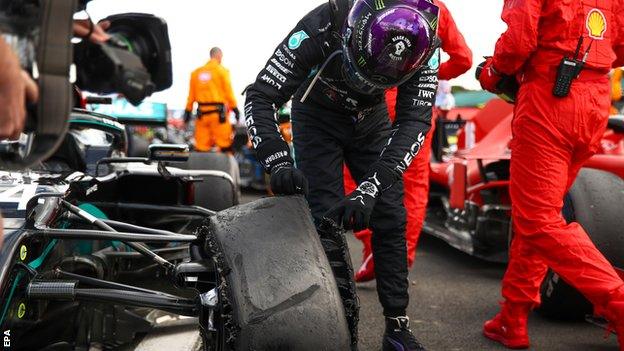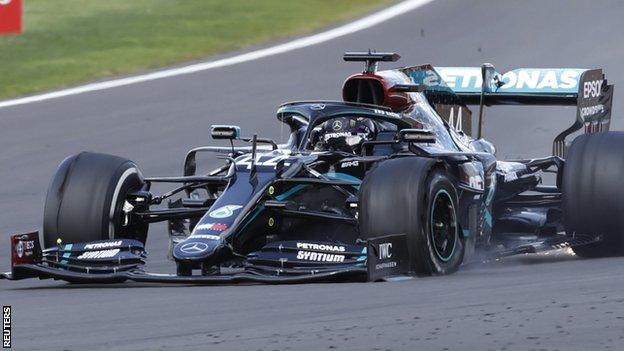Lewis Hamilton's British Grand Prix win: 'The most dramatic ending I can remember'
- Published

Next Sunday's 70th Anniversary Grand Prix at Silverstone is live on 5 Live and the BBC Sport website
There has never really felt much doubt about Lewis Hamilton winning this year's Formula 1 World Championship and there is even less after a previously uneventful British Grand Prix turned on its head in the final two laps.
Hamilton and his Mercedes team-mate Valtteri Bottas appeared to be cruising to a predictable one-two in the closing laps at Silverstone when all hell suddenly broke loose.
Bottas suffered a puncture with two laps to go, dropping out of the points, and then Hamilton hit the same problem on the final tour, and he faced an agonising final lap trying to drag his car home on three wheels before Max Verstappen's Red Bull caught him.
Hamilton managed it in what he described as "the most dramatic ending I can remember". And, with Bottas finishing 11th, the Briton now holds a 30-point lead after just four races.
There are probably around 12 or so races to go - no-one is quite sure at this stage in this coronavirus-affected season - but even so making up that deficit is a very tall order against a driver of Hamilton's abilities.
Certainly Verstappen thinks so. Can anyone stop Lewis, he was asked after the race? "No," he said.
Ferrari's Charles Leclerc, who was third, offered barely any more hope. "No," Leclerc said. "The guy that has some chances is Valtteri but that's it."
What caused all the tyre failures?
The events that led to this place came at the end of a race that had been pretty soporific at the front until then.
Two big crashes had caused early safety cars, and with the second all the front-runners stopped, still early in the race, and put on the hard tyres they expected to take them to the end. The combination of the accidents and the long stints was what ultimately led to the thrilling climax to the race.
Tyre supplier Pirelli said it would do a full investigation. But Hamilton said there was a lot of debris still on the track, and while the Mercedes drivers were managing their tyres while competing, there were clear signs of wear on them.
It seems likely that one factor or the other - or most likely both - is what led to the left-front punctures that affected not only Hamilton and Bottas, but also McLaren's Carlos Sainz and Alfa Romeo's Kimi Raikkonen.

Hamilton said his heart "definitely nearly stopped" when his tyre punctured at the end of the race
'I'm sure he just killed the tyre'
Hamilton, who had taken pole position on Saturday, almost lost the race with a slow start.
Bottas was alongside into the flat-out first corner, but Hamilton toughed it out on the outside and the Finn lifted and gave way, in a manner that some other drivers most certainly would not have.
Once the race had settled down, Hamilton and Bottas traded fastest laps, and for most of the afternoon were separated by less than two seconds. But heading into the final 10 laps, Bottas started to fall away. It was an early sign of the drama to come.
"We were pretty flat chat, to be honest," Hamilton said. "I felt like I drove really well and managed the tyres to the best of my ability.
"Valtteri was putting a lot of pressure on in the early parts of the stints, so in places I would normally manage I had to manage less. But I knew at some stage he was going to degrade because I could see he wasn't managing in areas he should. And then you started to see the gap opening up. I'm sure he just killed the left-front tyre and it started to drop off for him."
Bottas started to complain of a worsening vibration. The gap went out from 2.7 seconds to 8.3 in seven laps and then, as the Finn put it, "the puncture happened".
Before Bottas had even made it back around to the pits, Verstappen stopped for fresh tyres, partly to go for fastest lap, partly because he was "also not sure what was happening with my tyres".
The decision might have cost him the win, for going down the Wellington Straight on the final lap, just a bit further around the lap than Bottas' puncture, Hamilton also suffered a deflation.
"I was looking at the tyres," he said. "It was quite smooth. Through Turn Three it was turning fine.
"I was trying to gauge how worn it was and I didn't have any feeling of it being particularly worn and then suddenly on the straight the rpm drops as you start getting extra friction from the tyre not rolling at the same speed and you feel the car balance shift to the left. I nearly didn't make it around Turn Seven.
"In the heat of the moment you have the adrenaline flowing and the fight for survival instinct comes out and I was able to stay calm and measured and try to bring the thing home.
"But of course I was thinking of all the things that could have happened. If the tyre gave up in a high-speed corner, it would have been a different picture.
"I'm just incredibly grateful that it didn't. I heard Max was catching at a crazy speed. I got on to Hangar Straight and he was 19 seconds at that point and I was trying to pick up the speed but the wheel was making a real mess.
"I was thinking: 'How am I going to get through the last corners without losing too much time?' I got through 15 and then the last two corners were a disaster. I could hear: 'Seven, six, five' and I just managed to keep it together."

Bottas had to do a full lap with the damaged tyre
The shifting sands of fortune
Verstappen said he did not regret the decision to pit, pointing out that he, too, could have suffered a puncture had he not, and that he had finished second when he expected to be third.
"It's always easy to say afterwards," he said, "but we were also lucky today that Valtteri had a puncture so we gained a position.
"When you see other cars having punctures and you pitted the same lap it might happen to you as well, so we pitted just to be sure. Lewis had his puncture; that's unlucky. It is what it is and I am very happy with second."
Bottas, of course, was very far from happy, as he surveyed what he must surely realise is the early wreckage of his title hopes.
He won the first race, but Hamilton has now taken three poles and three wins in a row, and there seems little prospect of anyone else interfering in their private fight, such is Mercedes' performance advantage.
"Of course it is not ideal," Bottas said. "For the moment, if everything goes to plan with the calendar, there will be more than 10 races to go. The best bet will be to be on top of the points all the time. It is a big loss of points and these kinds you can't really afford.
"Lewis had a good race but he also got away with it in a way. What can I do? What can I say? It's not ideal but I can't change what has happened.
"So just really need to move on and take the learnings from the weekend, try again next week and keep positive. Because if I would decide myself now it is done, it's done for sure. I am definitely not going do that. I will keep pushing and keep believing and you never know what happens."
Hamilton almost sounded regretful that it had come to this so early in the season. Sitting in the news conference, with Verstappen and Leclerc either side of him, he said: "Honestly, I am a through-and-through racer at heart. In karting, you have wheel-to-wheel racing and that is what has always excited me.
"This is not the championship fight I would have hoped for. I would much have preferred to be having a super-close battle with these two here, because that's what really gets me going. I really, really hope it's closer in future."

There was a more unified response to the end racism protest at Silverstone
A more organised anti-racism protest
Hamilton's victory followed a fourth consecutive anti-racism protest by the drivers, much better organised this time than the haphazard and slightly chaotic attempts at the last two races.
After discussions between Hamilton and F1 bosses since the last race in Hungary, a specific time was allocated in the schedule, and places specified for the drivers, putting those who were planning to stand in a row behind those who would take the knee. This will continue for the foreseeable future.
F1 has made it clear - and the Grand Prix Drivers' Association have agreed - that all drivers are free to demonstrate their support for the sport's anti-racism and diversity drive as they see fit.
Some of the drivers view taking the knee as having political connotations with which they are not comfortable. And on Sunday, the number of drivers who chose to stand rather than take the knee alongside Hamilton increased by one compared to the first race of the season, Haas' Kevin Magnussen joining Verstappen, Leclerc, Sainz, Raikkonen, Alfa Romeo's Antonio Giovinazzi and Alpha Tauri's Daniil Kvyat.
On Thursday, Magnussen emphasised that he was "clearly for more inclusion and ending racism; it is only good we are putting awareness on this".
He added: "It's difficult for me to know how my actions are being perceived by others. I want to be participating in the message about ending racism. I am all for that. But I don't want to go into politics or be seen to support groups or organisations that I can't stand with."
Asked about this development afterwards, Hamilton said: "I'm not going to tell you my opinion on whether everyone needs to (take the knee) or not. But you look at other sports, at basketball and football, Spanish teams, Italian teams, teams all over the world, no matter what nationality or mixture they are, they are all doing it united. You've got players from Russia, from Spain.
"So it's a work in progress. When the reasoning for perhaps not doing it is how it will be perceived in your country, all you have to do is look at the other sports, because they are doing it.
"I do hope that bit by bit we can become more united, but I am really proud of all the drivers wearing the end racism T-shirt. I think there's progression.
"I don't know why Magnussen has done it. I have not spoken to him. But bit by bit we'll try to improve each other's understanding. The most important thing is the drivers continue to have respect for each other, which we do."
He added: "It's not the responsibility of minorities to have to go out and fight for rights, but unfortunately that's the scenario we're faced with.
"It is great to see people from different ethnicities all fighting together and asking for equality. And it's something we need to talk about because otherwise it will fade away and (racism will) continue and we can't have that. Your kids deserve equal rights in the future and the kids they go to school with deserve that.
"We are fighting for people to be fully aware it is not acceptable to be racist, to discriminate against others no matter what opinions or where they're from background-wise.
"I have so much respect for the drivers and we don't always have opportunities to really sit down together and talk.
"But I am more than happy to speak if it is something they want to do. I won't force it on people but I want to help the sport. If I can have any positive impact on other drivers, I am happy for that."
